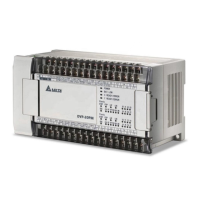3 Devices
DVP-20PM Application Manual
3-49
2. Bit 2 and bit 3 in D1816 (D1896, D1976): Ratio
Position: The home position of the axis specified, the target position of the axis specified (P (I)), the
target position of the axis specified (P (II)), and the present command position of the axis specified
must be multiplied by a ratio.
b3 b2 Ratio
0 0 Position×10
0
0 1 Position×10
1
1 0 Position×10
2
1 1 Position×10
3
3. Bit 4 and bit 5 in D1816 (D1896, D1976): Output type
b5 b4 Output type (positive logic) Description
0 0
FP Clockwise pulses
RP Counterclockwise pulses
Counting up/down
0 1
FP Pulses
RP Directions
Counterclockwise
Clockwise
Pulses+Directions
1 0 A/B-phase pulses
1 1
Counterclockwise
Clockwise
FP A-phase pulses
RP B-phase pulses
Four times the
frequency of
A/B-phase pulses
4. Bit 6 in D1816 (D1896, D1976): Setting a PWM mode
Bit 6=1: If positive JOG motion is started, Y0~Y3 will execute PWM.
5. Bit 8 in D1816 (D1896, D1976): Direction in which the axis specified returns home
Bit 8=0: The value indicating the present command position of an axis specified decreases, and the
axis returns home in the negative direction.
Bit 8=1: The value indicating the present command position of an axis specified increases, and the axis
returns home in the positive direction.
6. Bit 9 in D1816 (D1896, D1976): Mode of returning home
Bit 9=0: Normal mode
After DOG’s signal is generated, the motor used will rotate for a specific number of PG0 pulses, then
rotate for a specific number of supplementary pulses, and finally stop.
Bit 9=1: Overwrite mode
After DOG’s signal is generated, the motor used will rotate for a number of PG0 pulses or rotate for a
number of supplementary pulses, and then stop.
7. Bit 10 in D1816 (D1896, D1976): Mode of triggering the return to home
Bit 10=0: The return to home is triggered by a transition in DOG’s signal from high to low.
Bit 10=1: The return to home is triggered by a transition in DOG’s signal from low to high.
Bit [9:10] in D1816 (D1896, D1976) is 00.The mode of returning home is a normal mode, and the
return to home is triggered by a transition in DOG’s signal from high to low.
Steps: The motor used rotates at the speed V
RT
. When DOG’s signal is generated, the speed of the
motor begins to decrease to the speed V
CR
. After DOG’s signal goes from high to low, the motor will
rotate for a specific number of PG0 pulses, and then rotate for a specific number of supplementary
pulses, and finally stop.
If the number of PG0 pulses or the number of supplementary pulses is not large, the speed of the
motor used will decrease to the speed V
CR
after DOG’s signal is generated. After DOG’s signal
goes from high to low, the motor will rotate for a specific number of PG0 pulses, and then rotate for
a specific number of supplementary pulses, and finally stop whether the its speed is V
CR
.

